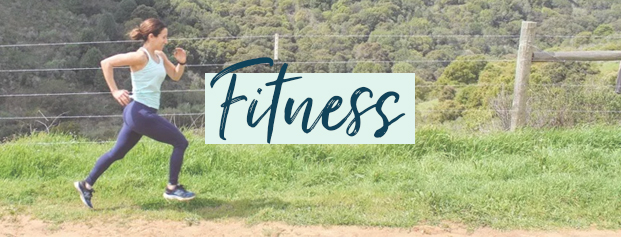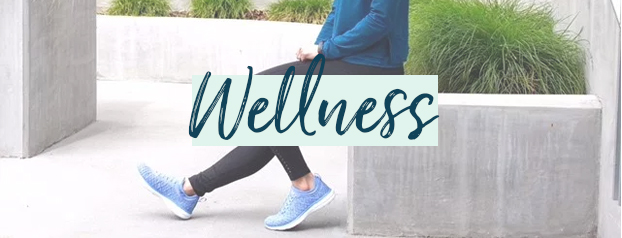As far as fitness + racing goes, triathlon is not a cheap sport. I did my first tri 6 years ago (on a whim, and look at me now!) and wasn’t sure I’d enjoy it so I looked to spend as little as possible while still purchasing good enough gear to get me to the finish line. It’s 6 years later and that entry level gear got me all the way here and I can tell you that it did me well. Maybe I didn’t have the fastest bike or the slickest wetsuit, but it didn’t matter. I’ve had a lot of heart along the way, plus it’s not like I was planning to win any of my races.
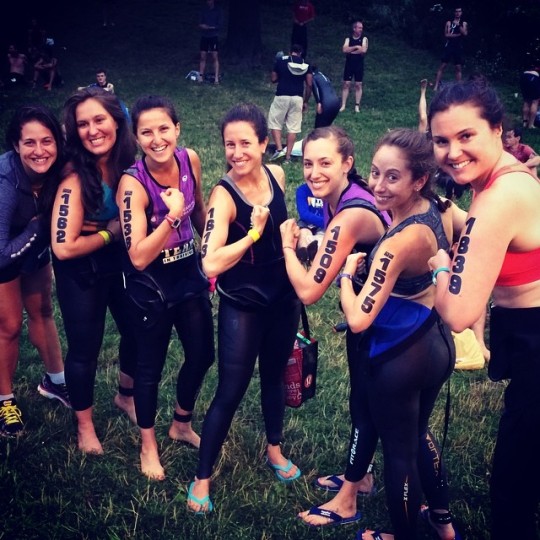
If you’re interested in doing a triathlon but you’re not sure it’s for you and you don’t want to go broke gearing up, there are plenty of brands and products that will work for you. Prior to your first tri, expect to spend about $1,500. Hopefully you will fall in love with the sport and it will be well-worth the investment. On the off chance you don’t love it, you can always sell your gear.
By now it’s clear that I love doing triathlons, I’ve stuck with the sport and since I’m taking it to the next level (Ironman 70.3), it was time to upgrade. Thankfully I had the support of Ironman and Coyne PR to help with these upgrades (thank you a million times over!) and with their help I can give you gear recommendations for beginners and those looking to take it to spend more and get more. Here’s a look at my gear progression over the years:
Bike
My starter road bike was the Trek 1.2. This is an ideal lower-end bike, coming in under $1,000, but will still make you feel super fast if you’re coming off of a hybrid or even mountain bike. It’s sturdy and well-made. In my 6 years with this bike I’ve never had a flat tire or anything break. To keep your bike riding in tip top shape, make sure to get tune ups throughout the season. When you go to purchase your bike, ask about their tune-up deal. I bought this one at Metro Bikes and they offered 3 years of free tune-ups with purchase.
HERE is the current Trek 1.2 model and below is mine (not sold anymore because it’s so old!).
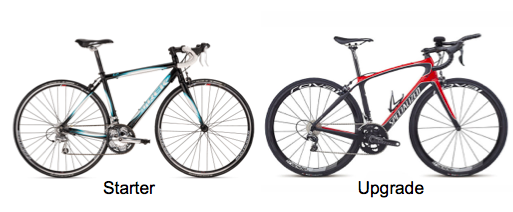
This year I upgraded to the Specialized Alias Pro Tri ($6,000). If you’re looking at prices you are probably thinking that it’s quite a huge jump from my first bike to this, and I agree. But knowing that I love the sport and will do it for years to come makes this a worthy investment. If you are looking for a less expensive upgrade, there is also the Alias Comp Tri ($3,300) and the Alias Sport Tri ($2,600).
What I love about the Alias is that it’s a serious bike without being a scary bike. What I mean by that is that it has aero bars but is built like a road bike so if you aren’t in competition mode and are just out on a nice long ride, you don’t need to be in aero position, you can ride it like a road bike. In fact, the aero bars are removable. But come race day, you can speed along in aero. The Pro Tri has a carbon frame, is super light and has a comfortable saddle so even 50 miles in, you’ll still be feeling good. The gears shift extremely fast with this bike, as soon as you hit the gear, it has smoothly shifted. Simply put, this bike makes riding feel easier than my last bike, no matter how big a hill I’m climbing.
Cycling Shoes
My original spin/cycling shoes (Shimano SH-WM Shoes) are so old they can only be found on ebay. Also while trying to track down which pair I had, I discovered they were mountain biking shoes, good job Amanda! I had these for years, initially for indoor cycling class. They were great for that because the clips are recessed making it easy to walk around the room without slipping (which is key as the instructor). I retired these shoes because one day I arrived at spin class to realize I only had one shoe! One must have fallen out of my bag on the way to class, never to be seen from again, tear. But that’s ok, it lead me to better things.
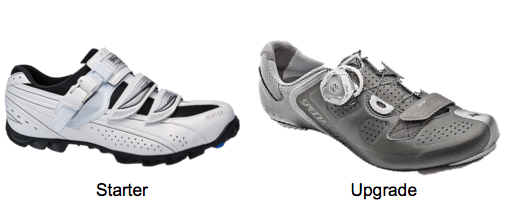
I have a different pair that I use for class now, but for my upcoming race I’ll be wearing the Specialized Zante ($200). These are designed to optimize hip, knee and foot alignment. There is lots of technical talk on the site that you can check out, but from a user-perspective, these shoes are comfortable, supportive, light, give me clean powerful movements and feature a very cool snap dial closure that makes getting these shoes on and off fast and easy (important for race transitions).
Wetsuit
Depending on the tri you choose, you might not even need or want a wetsuit. Since I’ve done the NYC Tri 6 times in the Hudson River, you know I was going to use a wetsuit! Aside from keeping river grime off me, I love the extra buoyancy a wetsuit provides.
Before my first tri I opted for the cheapest suit from a recommended brand, the Xterra Vortex Sleeveless ($159). I wanted a full-sleeved suit but they were out of my price range so I settled for this one which has served me well. In the end, I didn’t mind the sleeveless version because it allowed me easy movement in my arms. This suit has 5.0 mm-thick neoprene on the front and 3 mm Super GKA neoprene on the back.
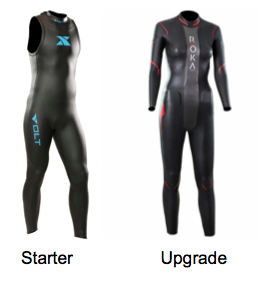
For my Ironman 70.3 I’m moving on to the Roka Women’s Maverick Elite Fullsuit ($549). This suit incorporates different thicknesses of neoprene throughout the suit, depending on the area. There is super-thin neoprene in the arms, shoulders, chest and back, covering the dominant working muscles for the freestyle stroke. There is a thicker, less stretchy neoprene in the core and legs to give support and stability. Because of the design, some parts of the suit stretch more than others giving you comfort, speed and support. There is more buoyancy in the legs than in the chest, it stabilizes the core and ankle panels lead to a faster transition out of the suit.
Don’t get me wrong my Xterra was a totally fine suit, but when you read the specs, you can see why the Roka is a big step up in quality and design. Swimming in the Roka suit is a totally new experience. You literally are floating above the water with no effort. Sure, the swim will take effort, but you have to feel the buoyancy of this suit to believe it.
Watch
I can’t believe two things, first that I’ve trained and raced this long without a GPS watch, and second that I was able to find a picture of my sports watch that I purchased back in 2008 the day before I ran my first NYRR NYC Half Marathon. That cute Nike standard watch took me through that half, then 6 more halves and a full marathon, plus 7+ triathlons. Literally the only thing that watch could do was take basic timing, start and stop and that’s it.
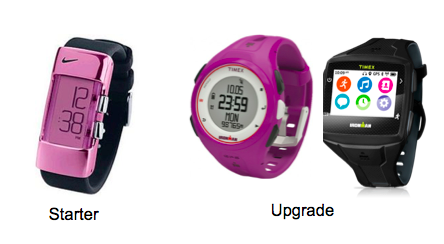
FINALLY, I upgraded and man oh man, why did I wait so long. A GPS watch makes a huge difference in training. I’ve been playing around with the Timex Ironman Run x20 (middle, $79.99) and The Ironman One GPS+ (right, currently on sale for $199).
The Ironman One GPS + watch is pretty amazing. It’s basically like a cell phone on your wrist. Aside from the GPS functionality, it can play music through bluetooth headphones, you can send and receive text messages, you can enable a “Find Me” feature that allows designated contacts to see your location, you can designate an “Angel” in the system so they are notified when you start and stop your workout, plus a ton of other features (read them all HERE). The one downside of this watch is that it’s very large and a bit too bulky for me (thin-wristed people like myself beware). For my race I think I’m going to put this on my handlebars of my bike so that my family can track my location and I can keep track of my mileage without actually wearing the watch.
The middle watch above, the Timex Ironman Run x20 ($79.99) is a more standard GPS watch, it tracks real-time speed, pace, distance and calories. It’s easy to read and simple to use. I’m going to wear this for the full race. With GPS mode enabled, the battery life is 6 hours which sadly is not long enough for my projected time, so I’ll only plan to use the GPS on the run (which makes sense since I’ll have the other watch tracking me on the bike). A fun feature I will use with this watch is the interval timer. I’ve been told one of the trickiest parts of these long races is remembering to eat and drink enough. Every 20 minutes I’ll have the watch beep to remind me to drink and or eat.
Triathlon is definitely a sport that costs money, but it’s up to you how serious you want to get about your gear. My recommendation is to start with low or mid-level gear, see how you like the sport and gradually upgrade through the years. I know that the price tag of a first tri can be daunting but if you think this sport might be for you, trust me, it’s worth it. You’re investing in your health and your passion, a very worthy way to spend your money.





